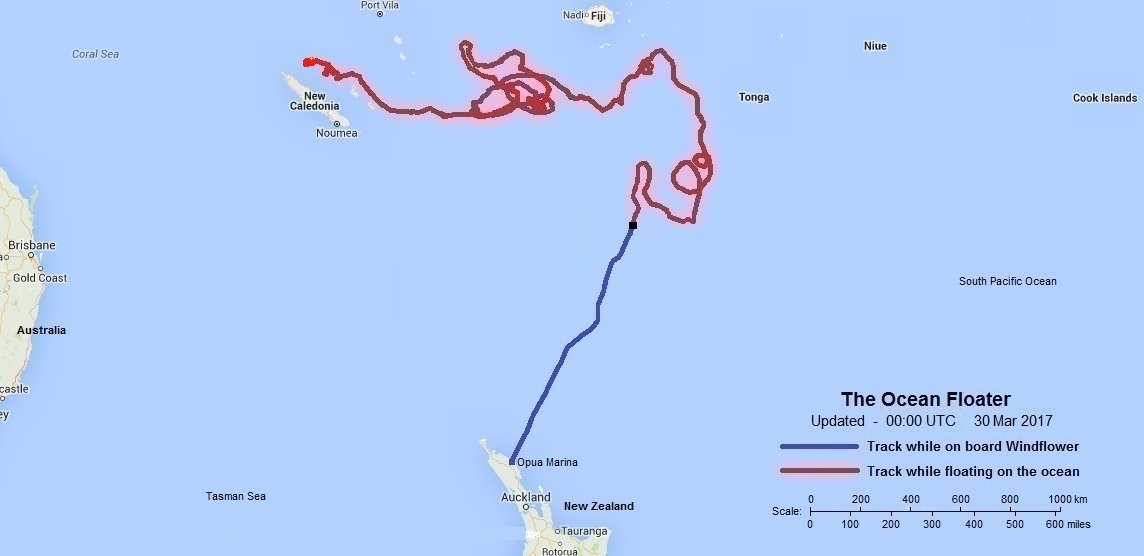1. New VFO/SigGen kit firmware s1.04 has Quadrature output mode
2. U3S UHF DX: 4000+km on 432MHz, Hawaii to California
3. 24GHz Opera first, using Ultimate3S
4. U3S 60m DX: First G-ZL QRSS
5. 3D printed QLG1 enclosure by Chris OE1CGS
6. New ProgRock firmware pr1.01a adds serial port for configuration
7. Balloon flights and ZL1RS ocean buoy news
8. Peter G4HSO transatlantic voyage planned in April
9. Social media, Feedback, unsubscribing
1. New VFO/SigGen kit firmware s1.04 with Quadrature output mode
An enhancement to the VFO/SigGen kit was made in firmware version s1.04 which provides a Quadrature output mode for the Clk1 output. Specifically, there are now 6 possible modes for the Clk1 output, as follows:
- Fixed: Clk1 is set to a fixed frequency as specified in the "Clk1" parameter
- Phase 0: Clk1 and Clk0 on the same frequency and in phase
- Phase 90: Clk1 on the same frequency as Clk0 but with 90 degree phase offset
- Phase 180: Clk1 and Clk0 on the same frequency but out of phase
- Phase 270: Clk1 on the same frequency as Clk0 but with 270 degree phase offset
- IF Offset: Clk1 is offset to Clk0 by the frequency specified in the "IF Offset" parameter
The quadrature modes (90 degree and 270 degree phase offset) may be useful in directly driving Quadrature Sampling Detectors (QSD), also known as Tayloe Detectors (or modulators). The QRP Labs Receiver module kit and many SDRs use this detector. Usually a 4x Frequency VFO is required, which drives a divide-by-4 circuit using a dual D-type flip-flop chip such as the 74AC74. Generating quadrature directly eliminates the need for the 74AC74. It may potentially allow receiver operation up to much higher frequencies, since the 74AC74 cannot go beyond the 10m band (28-30MHz) but the Si5351A chip can generate quadrature LO signals right up to its upper frequency limit of 200MHz (datasheet specification).
The accuracy of the quadrature phase shift at VHF remains to be seen (tested). So far QRP Labs have tested the Si5351A directly driving a QSD in a homebrew 40m CW transceiver, with excellent results. It is at least as good as when using a 74AC74 and 4x LO (see below right). The experiment was repeated in a 20m CW transceiver with the same result.
As usual the new firmware version chip is available in the QRP Labs shop here; or if you have AVR programming equipment you can download the .hex file and upgrade your existing chip, from the QRP Labs group.

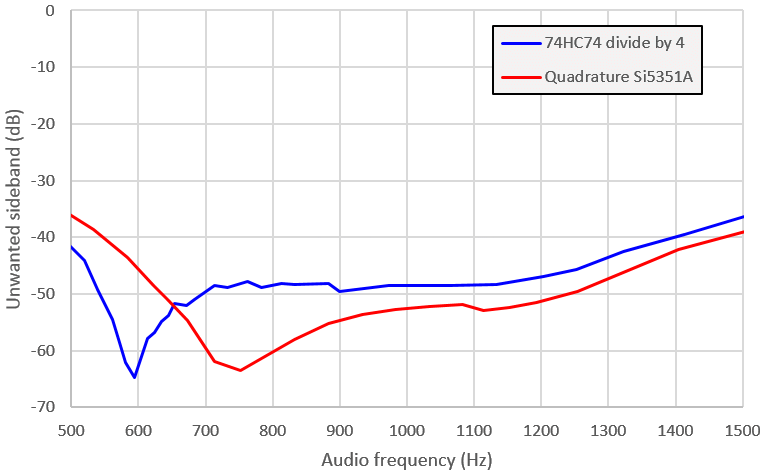
2. Ultimate3S UHF DX: 4,000+km on 432MHz, Hawaii to California
I am hearing of an increasing number of VHF and UHF beacons being upgraded using the Ultimate3S transmitter kit as a multi-mode exciter.
Glenn N6GN reports that on 16-Mar-2017 the new Hawaii Big Island 70cm multi-mode beacon KH6HME was copied on the US mainland in California by two stations N3IZN and W6IT, using WSPR and JT9. A distance of over 4,000km!
The KH6HME multi-mode beacon project was masterminded by Glenn N6GN, and implemented together with local amateurs in Hawaii. The legacy 70cm beacon at KH6HME was CW only and it was felt that adding weak-signal modes would aid the discovery and understanding of 70cm propagation openings over the Hawaii-Mainland path.
The new KH6HME beacon uses an Ultimate3S transmitter kit as the exciter, operated at a frequency of 32MHz. A Bodnar GPSDO Frequency reference has dual output. An output at 25MHz is used as the reference oscillator for the Si5351A Synth in the Ultimate3S, while a 400MHz output mixes with the 32MHz Ultimate3S output to get the desired 70cm band output on 432MHz. A power amplifier and 70cm band pass filter complete the beacon. The Ultimate3S is set up to transmit CW, JT9, JT65 and WSPR on the following schedule:

The full story of the beacon development, operation and programming makes really fascinating reading! I'd strongly recommend you to have a look, see Glenn N6GN's page at http://www.sonic.net/~n6gn/HI70cm/HI70cm.html
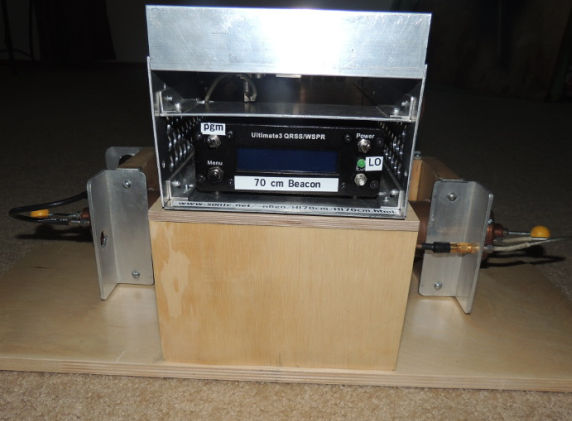
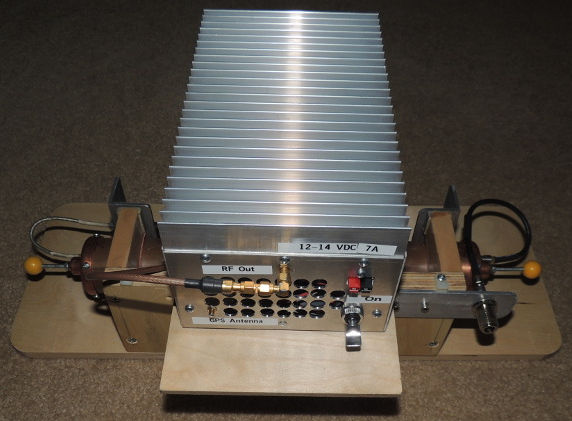
3. 24GHz Opera first, using Ultimate3S
Now going even to higher frequencies, MUCH higher in fact - the first ever Opera reception on 24GHz was reported on 20-Mar-2017 over a path of 268km. The ED5YAE beacon is located at JM08AT. It was received by Iban EB3FRN at grid locator JN01MC, a 268km sea path without land obstructions.
The ED5YAE 24GHz beacon uses an Ultimate3S transmitter kit operated at 144MHz, and feeding a transverter with about 1W output on 24GHz into a horn antenna. The transmission includes CW, Opera05, and a solid carrier section.
A screenshot of the decoders in action can be seen here: https://dl.dropboxusercontent.com/u/7162072/docs/Opera/yae24d1.png
The Ultimate3S kit is most often used for WSPR transmissions so it is nice to see some activity on other modes.
4. U3S 60m DX: First G-ZL 60m QRSS
Now another nice reminder of all the things (other than WSPR) that the Ultimate3S transmitter kit is capable of! The first 60m QRSS G-ZL reception was reported on 22-Mar-2017. Keith G6NHU's Ultimate3S on 60m with about 250mW from the East coast of England was copied in New Zealand by Pete ZL2IK. The same again the following evening (see screenshot, below). This image is obtained by the averaging (or "stacking") technique, where in this case 7 consecutive 10-minute frames are superimposed, re-enforcing the wanted signal and averaging out the noise. Precise timing at the Ultimate3S transmitter and the receiving station's decoding computer make this possible.

So it you've so far only used WSPR on your Ultimate3S transmitter kit - why not try some of the other modes the kit has to offer? Remember that the kit can transmit: conventional QRSS modes (QRSS, FSKCW, DFCW), CW, Slow-MFSK Hellschreiber and standard Hellschreiber, WSPR (and WSPR-15), JT9 (all variants), JT65 (all variants), ISCAT (A, B), PI4, and Opera (all variants). RTTY and JT4 are coming soon also!
5. 3D printed QLG1 enclosure by Chris OE1CGS
Chris OE1CGS has designed a beautiful 3D printable enclosure for the QLG1 GPS receiver kit. The QLG1 GPS receiver has very high sensitivity due to the large PCB groundplane under the onboard ceramic patch antenna. But however sensitive it is, you can't beat the physics - in this case Faraday's cage! If you put an antenna inside a metal enclosure the RF cannot get in. These are the rules! Hence the QLG1 GPS receiver cannot be installed inside the QRP Labs Ultimate3S aluminium enclosure (for example), unless an external GPS antenna is used.
The need for a non-metalic case then arises for most constructors. Chris OE1CGS solved this problem with his stylish 3-D printed design made from ABS plastic. If you own or have access to a 3D printer, you can use the model at http://www.thingiverse.com/thing:2167408.

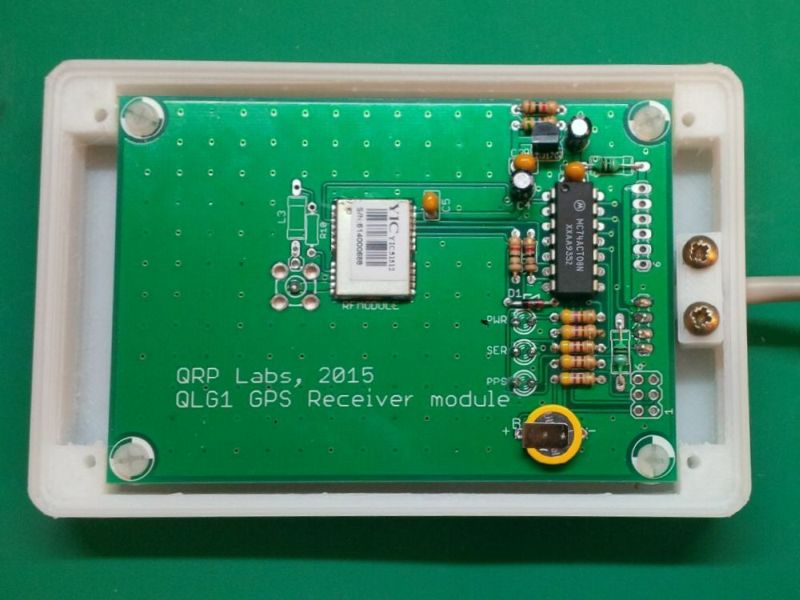

6. New ProgRock firmware pr1.01a adds serial port for configuration
A new firmware release pr1.01 (subsequently updated to pr1.01a, to fix an initialisation bug fix) includes the option to configure the ProgRock (programmable crystal replacement) kit using a serial port.
The ProgRock kit costs $18 including the Si5351A Synth kit and provides lots of features:
- Includes Si5351A Synth kit AND "ProgRock" PCB kit
- Easy construction, no surface-mount components to solder (Si5351A already pre-soldered)
- 3 independent 3.3V p-p squarewave outputs (2 if you use GPS discipline)
- You can feed the outputs through LPF kits to get sinewave outputs
- 8 selectable “banks” of frequencies, chosen by 3 input control signals
- Frequency range 3.5kHz to 200MHz
- Extended frequency range up to approx. 300MHz if you don’t mind violating the Si5351A datasheet specifications
- GPS frequency discipline using 1pps from a GPS receiver such as the QRP Labs QLG1 GPS receiver kit
- Unique power supply noise filter circuit designed by Alan Gray G8LCO
- Power supply voltage 5V, or using LM317LZ regulator (supplied), range is 5-12V DC
- Minimalist configuration user interface using 4-way DIP switch, push button, and LED
- Optional serial port configuration
- Frequencies and configuration stored in non-volatilte memory (EEPROM) for next power-up
Custom manufactured crystals are becoming harder to obtain. In March 2017 International Crystal Manufacturing (ICM), a US custom crystal supplier, went out of business. The ProgRock kit can provide a useful alternative to a custom-manufactured crystal in many applications - as well as being cheaper, providing multiple outputs with optional GPS discipline, and being re-usable by reprogramming it to other frequencies if you need to do so in future!
The addition of the serial port configuration facility adds another method to configure ProgRock, potentially simpler than the DIP switches; it may also open up new applications where a remotely adjustable synthesised frequency is required.
7. Balloon flights and ZL1RS ocean buoy news
Bob ZL1RS ocean floater
Bob ZL1RS reports that as of 30-Mar-2017 his ocean floater has been in the South Pacific for 316 days! An amazing endurance! The current position is RH20NN, about 100km North East of the northern end of New Caledonia. The Ultimate3S-based transmitter on board transmits WSPR and JT9 once per hour. Bob reports that the battery discharge is accelerating quickly now. The battery pack consists of 18 alkaline D-cell batteries. As the battery voltage declines, the current drawn increases more and more.
In the last month the ocean floater drifted along the coast of the loyalty islands East of New Caledonia. It evidently survived several close-encounters with reefs which could have destroyed it.
See Bob ZL1RS' web page http://www.qsl.net/zl1rs/oceanfloater.html for more details!
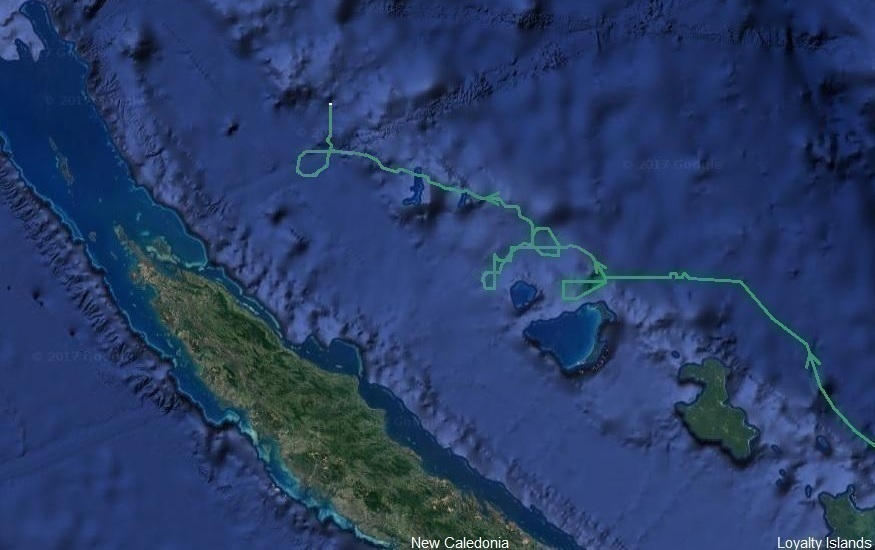
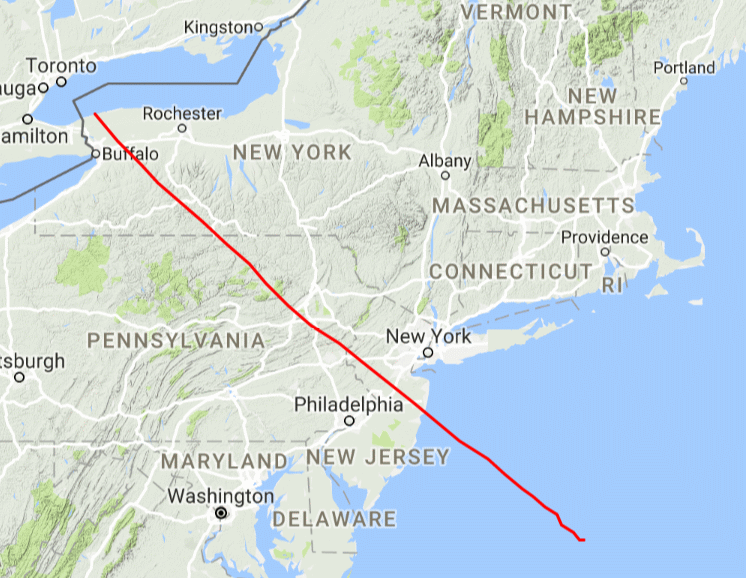
Dave VE3KCL balloon flight S22
Dave VE3KCL launched his Ultimate3S-based flight S22 on 17-Mar-2017 and it quickly climbed to altitude and headed south-east, crossing the US and out over the Atlantic. There were no transmissions in the first hour or so of the flight as it was very early morning and the sun angle was not enough to provide sufficient power to the solar cells.
However there appears to have been a balloon leak, Dave thinks this batch of balloons from the manufacturer has defects along its perimeter seals. S22 started a long slow descent and the flight was over after 8 hours, landing in the Atlantic ocean.
Mikael SA6BSS flight BSS4
Mikeal SA6BSS launched his Ultimate3S-based balloon flight BSS4 on 26-Mar-2017. It is transmitting WSPR on 20m and 17m; there is also a JT9 transmission on 20m containing the altitude. At time of writing (30-Mar-2017) the balloon was off the coast of Algeria at an altitude of around 9,000m, and should soon be beginning a North Africa tour and heading to the Middle East next.
8. Peter G4HSO transatlantic voyage planned in April
Peter G3HSO is currently in the Caribbean and will be sailing a 13.7m / 45ft boat across the Atlantic, planned to start in early April, arriving in the UK in May 2017. He will be using an Ultimate3S to transmit his location on 20m WSPR, with callsign G4HSO/M on the water (/MM not technically possible due to WSPR protocol limitations). We hope to provide a live tracking map on the QRP Labs web page. Please watch the https://groups.io/g/QRPLabs for updates.
9. Social media, feedback, unsubscribing
Social media: QRP Labs has the following presence on social media. If you use these social media then please join or follow QRP Labs! Announcements such as new products, balloon launches, etc., will be made first in these media!
1) QRP Labs groups.io discussion group https://groups.io/g/QRPLabs for discussion and support on all QRP Labs products
2) QRP Labs Facebook page https://www.facebook.com/QRPlabs/
3) QRP Labs is @qrplabs on Twitter https://twitter.com/qrplabs
Feedback: As always, please do write with any comments, ideas, criticism, feedback of any kind!
Unsubscribing: If you want to unsubscribe from this monthly newsletter, then either log in to your QRP Labs shop account and un-check your newsletter preference, OR, email and we'll take care of it.

